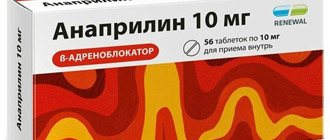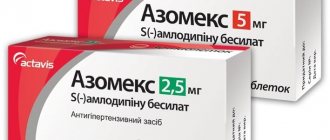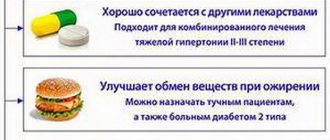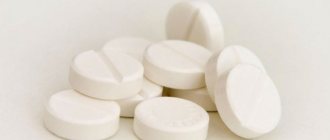Compound
Coated tablets contain 10 mg of nifedipine each as an active substance. Excipients: polyvinyl butyral in an amount of 0.7 mg; talc (1 mg); 0.3 mg magnesium stearate ; 4 mg hydroxypropylcellulose ; lactose monohydrate (15 mg); croscarmellose sodium (13 mg); microcellulose (46 mg). The shell consists of hypromellose - 2.63 mg; titanium dioxide CI 77891 - 0.82 mg; yellow iron oxide - 0.3 mg and magnesium stearate - 0.25 mg.
Long-acting film-coated tablets contain the same active substance, but in a dose of 20 mg. Each of them contains the following substances as auxiliary substances: microcellulose (99 mg); lactose monohydrate (30 mg); croscarmellose sodium (26 mg); copolymers of methyl methacrylate and ethyl methacrylate in a ratio of 1:2 (1.9 mg); talc (2 mg); magnesium stearate (0.6 mg); hyprolose (0.5 mg). The film shell is made of hypromellose - 5.26 mg; titanium dioxide - 1.64 mg; red iron oxide - 0.6 mg; magnesium stearate - 0.5 mg.
Release form
There are two options for the release form of the drug:
- Coated tablets, weighing 10 mg. Every 100 tablets are placed in a brown glass bottle. The bottles are individually packaged in cardboard boxes.
- Film-coated tablets with prolonged action. Each tablet weighs 20 mg. Place 30 or 60 tablets in brown glass bottles. Vials must be sealed with polyethylene caps that have a first-opening control. The bottle is packed in a cardboard box.
Pharmacodynamics and pharmacokinetics
Nifedipine is a selective blocker of slow calcium channels, one of the 1,4-dihydropyridine derivatives. Its effect is manifested in a decrease in the flow of extracellular calcium ions into cardiomyocytes and smooth muscle cells of the arteries. Nifedipine can also increase renal blood flow, causing moderate natriuresis .
After taking one tablet of Cordaflex, which has a prolonged action, the clinical effect usually develops after 20 minutes, the effect lasts from 12 to 24 hours.
After administration, it is quickly, almost completely (at least 90%) absorbed from the digestive tract. And the bioavailability of the drug is in the range of 40-70%.
The maximum concentration of the active substance in the blood is found 30-60 minutes after taking the drug.
After taking one tablet with a prolonged action, the therapeutic concentration in the blood plasma is achieved within an hour and remains at an equal level for up to 6 hours; over the next 30-36 hours, a gradual decrease in concentration is observed.
Nifedipine has the property of binding to blood plasma proteins, in particular albumins , penetrating the blood-brain barrier (in small quantities - no more than 5%), through the placenta , and can be excreted in breast milk.
The half-life is 2 hours for a 10 mg tablet; for a 20 mg extended-release tablet it is approximately 3.8-16.9 hours.
Cordaflex® RD
Pharmacokinetic interactions
Medicines that affect the metabolism of nifedipine
Nifedipine is metabolized by CYP3A4/5 isoenzymes, which are located in the intestinal mucosa and liver. Drugs that inhibit or induce this enzyme system may affect the first pass effect through the liver (after oral administration) or the clearance of nifedipine.
Inducers of the CYP3A4 isoenzyme
Rifampicin
Rifampin is a potent inducer of the CYP3A4 isoenzyme. When used simultaneously with rifampicin, the bioavailability of nifedipine is significantly reduced and, accordingly, its effectiveness is reduced. Therefore, the simultaneous use of nifedipine with rifampicin is contraindicated.
Antiepileptic drugs that induce CYP3A4 (eg, phenytoin, carbamazepine, phenobarbital)
Phenytoin induces the CYP3A4 isoenzyme. With the simultaneous use of nifedipine and phenytoin, the bioavailability of nifedipine is reduced and its effectiveness is reduced. When using this combination simultaneously, it is necessary to monitor the clinical response to nifedipine therapy and, if necessary, increase its dose. If the dose of nifedipine is increased with simultaneous use of both drugs, the dose of nifedipine should be reduced after discontinuation of phenytoin. Clinical studies examining the potential interaction between nifedipine and carbamazepine or phenobarbital have not been conducted. Since both drugs reduce the concentration of nimodipine in the blood plasma, which is structurally similar to BMCC, the possibility of a decrease in the concentration of nifedipine in the blood plasma and a decrease in its effectiveness cannot be excluded.
CYP3A4 isoenzyme inhibitors
Macrolide antibiotics (for example, erythromycin)
Clinical studies on the interaction of nifedipine and macrolide antibiotics have not been conducted. Some macrolides are known to inhibit the CYP3A4 isoenzyme. As a result, the possibility of an increase in the concentration of nifedipine in the blood plasma cannot be excluded with the simultaneous use of nifedipine and macrolide antibiotics.
Azithromycin, a macrolide antibiotic, does not inhibit the CYP3A4 isoenzyme.
HIV protease inhibitors (eg, ritonavir)
Clinical studies examining the interaction of nifedipine and HIV protease inhibitors have not been conducted. It is known that drugs of this class inhibit the CYP3A4 isoenzyme. In addition, drugs of this class have been shown to suppress the metabolism of nifedipine mediated by the CYP3A4 isoenzyme in vitro.
When used simultaneously with nifedipine, a significant increase in the concentration of nifedipine in the blood plasma cannot be ruled out due to a decrease in the effect of “first pass” through the liver and slower elimination.
Azole antifungals (eg, ketoconazole)
Clinical studies examining the interaction of nifedipine and azole antifungals have not been conducted. It is known that drugs of this class inhibit the CYP3A4 isoenzyme. When used simultaneously with nifedipine, a significant increase in the systemic bioavailability of nifedipine is possible by reducing the effect of “first pass” through the liver.
Cimetidine and ranitidine
It has been established that cimetidine and ranitidine inhibit the CYP3A4 isoenzyme and cause an increase in the concentration of nifedipine in the blood plasma (by 80% and 70%, respectively), thereby enhancing its antihypertensive effect.
Diltiazem
Diltiazem reduces the clearance of nifedipine. This combination should be used with caution. A dose reduction of nifedipine may be required.
Fluoxetia
Clinical studies examining the interaction of nifedipine and fluoxetine have not been conducted. It is known that fluoxetine in vitro
suppresses the metabolism of nifedipine mediated by the action of the CYP3A4 isoenzyme. Therefore, the possibility of an increase in the concentration of nifedipine in the blood plasma cannot be excluded with the simultaneous use of nifedipine and fluoxetine.
Nefazodone
Clinical studies examining the interaction between nifedipine and nefazodone have not been conducted. Nefazodone is known to inhibit the metabolism of other drugs mediated by the CYP3A4 isoenzyme. Therefore, the possibility of an increase in the concentration of nifedipine in the blood plasma cannot be excluded with the simultaneous use of nifedipine and nefazodone.
Quinidine
Increased plasma concentrations of nifedipine have been reported when administered concomitantly with quinidine. Therefore, when using quinidine and nifedipine simultaneously, careful monitoring of blood pressure is necessary. If necessary, the dose of nifedipine should be reduced.
Quinupristin/dalfopristin
Concomitant use of quinupristin/dalfopristin may lead to increased plasma concentrations of nifedipine.
Valproic acid
Clinical studies examining the interaction of nifedipine and valproic acid have not been conducted. Since valproic acid increases the concentration of nimodipine in the blood plasma, which is structurally similar to BMCC, the possibility of increasing the concentration of nifedipine in the blood plasma and enhancing its effectiveness cannot be excluded.
Grapefruit juice
Grapefruit juice inhibits the CYP3A4 isoenzyme and suppresses the metabolism of nifedipine. The simultaneous use of nifedipine with grapefruit juice leads to an increase in the concentration of nifedipine in the blood plasma and a prolongation of its action due to a decrease in the effect of “primary passage” through the liver and a decrease in clearance. This may enhance the antihypertensive effect of nifedipine. With regular consumption of grapefruit juice, this effect can last for 3 days after the last consumption of the juice. The consumption of grapefruit/grapefruit juice during treatment with nifedipine is contraindicated (see section Contraindications).
CYP3A4 isoenzyme substrates
Substrates of the CYP3A4 isoenzyme (for example, cisapride, tacrolimus, benzodiazepines, imipramine, propafenone, terfenadine, warfarin), when used simultaneously with nifedipine, may act as CYP3A4 inhibitors and increase the concentration of nifedipine in the blood plasma.
Cisapride
Concomitant use of cisapride and nifedipine may lead to increased plasma concentrations of nifedipine.
Effect of nifedipine on other drugs
Quinidine
Nifedipine causes a decrease in the concentration of quinidine in the blood plasma. After discontinuation of nifedipine, a sharp increase in the concentration of quinidine in the blood plasma may occur. Therefore, when using nifedipine as additional therapy or discontinuing nifedipine, the concentration of quinidine in the blood plasma should be monitored and, if necessary, its dose should be adjusted.
Digoxin
The simultaneous use of nifedipine and digoxin may lead to a decrease in the clearance of digoxin and, consequently, to an increase in the concentration of digoxin in the blood plasma. The patient should be carefully monitored for symptoms of glycoside overdose and, if necessary, reduce the dose of digoxin, taking into account its concentration in the blood plasma.
Theophylline
Nifedipine increases plasma concentrations of theophylline, and therefore the concentration of theophylline in blood plasma should be monitored. The clinical effect of both drugs when used together does not change.
Tacrolimus
Tacrolimus is metabolized with the participation of the CYP3A4 isoenzyme. Recently published data indicate the possibility of increased tacrolimus concentrations in selected cases when administered concomitantly with nifedipine. When using tacrolimus and nifedipine simultaneously, the concentration of tacrolimus in the blood plasma should be monitored and, if necessary, its dose should be reduced.
Vincristine
Nifedipine slows down the elimination of vincristine from the body and may cause increased side effects of vincristine. If simultaneous use is necessary, reduce the dose of vincristine.
Drugs that bind to blood proteins
Nifedipine can displace drugs characterized by a high degree of binding from protein binding (including indirect anticoagulants - coumarin and indanedione derivatives, anticonvulsants, non-steroidal anti-inflammatory drugs (NSAIDs), quinine, salicylates, sulfinpyrazone), as a result of which their concentration may increase in blood plasma.
Cephalosporins
With the simultaneous administration of cephalosporins (for example, cefixime) and nifedipine in probands, the bioavailability of the cephalosporin increased by 70%.
Pharmacodynamic interactions
Medicines that lower blood pressure
The antihypertensive effect of nifedipine may be enhanced when used simultaneously with antihypertensive drugs, such as diuretics, beta-blockers, angiotensin-converting enzyme (ACE) inhibitors, angiotensin II receptor antagonists (ARA II), other BMCCs, alpha-blockers, phosphodiesterase-5 inhibitors, methyldopa.
When using nifedipine and beta-blockers simultaneously, it is necessary to carefully monitor the patient's condition, since in some cases the course of CHF may worsen.
The severity of the decrease in blood pressure increases with the simultaneous use of inhalational anesthetics and tricyclic antidepressants.
Nitrates
When used simultaneously with nitrates, tachycardia increases.
Antiarrhythmic drugs
BMCCs can enhance the negative inotropic effect of antiarrhythmic drugs such as amiodarone and quinidine. Nifedipine should be co-administered with disopyramide and flecainide with caution due to a possible increase in negative inotropic effect.
Magnesium sulfate
It is necessary to carefully monitor blood pressure in pregnant women while using nifedipine with intravenous magnesium sulfate due to the possibility of an excessive decrease in blood pressure, which is dangerous for both the mother and the fetus.
Fentanyl
The simultaneous use of nifedipine and fentanyl can lead to severe arterial hypotension. If possible, it is recommended that nifedipine be discontinued at least 36 hours before fentanyl-based anesthesia.
Calcium preparations
Reduced effectiveness of nifedipine.
NSAIDs
NSAIDs reduce the antihypertensive effect of nifedipine due to suppression of prostaglandin synthesis, sodium and fluid retention in the body.
Sympathomimetics
Sympathomimetics reduce the antihypertensive effect of nifedipine.
Estrogens
Estrogens reduce the antihypertensive effect of nifedipine due to fluid retention in the body.
Lithium preparations
When BMCC is used together with lithium drugs, it is possible to increase the manifestation of the neurotoxicity of the latter (nausea, vomiting, diarrhea, ataxia, tremor, tinnitus).
Contraindications
Contraindications are:
- intolerance to nifedipine , other 1,4-dihydropyridine , additional components included in the tablets;
- arterial hypotension;
- unstable angina;
- the current or recent presence of acute myocardial infarction or severe aortic stenosis ;
- idiopathic subaortic stenosis;
- chronic heart failure during the period of decompensation;
- childhood.
It is prescribed with special caution to elderly patients, those with impaired renal function, and patients with diabetes mellitus .
Side effects
Cordaflex is usually well tolerated. Side effects appear rarely, more often at the beginning of treatment (then they may become weaker or disappear).
There are such side effects:
- On the heart and blood vessels: decreased blood pressure, flushing of the face and torso, swelling in the extremities , accelerated heart rate, paradoxical attack of angina , development of acute heart failure .
- On the nervous system: increased fatigue , dizziness , weakness , emotional lability , sleep disturbances, headache, tremor , paresthesia .
- On the gastrointestinal tract: the occurrence of heartburn , nausea , vomiting , flatulence , stool disorders, dryness or inflammation of the oral mucosa, intrahepatic cholestasis , as well as increased activity of certain liver enzymes.
- On the circulatory system: thrombocytopenia , leukopenia , anemia .
- On the urinary system: increased daily diuresis, night urination , decreased renal function.
Allergic reactions may occur in the form of urticaria , exanthema , and skin itching .
conclusions
Cordaflex is a highly effective antianginal and antihypertensive agent from the group of calcium channel blockers. Due to this, as well as its low cost, it has become widespread in the treatment of acute attacks of cardiovascular diseases.
However, it has a number of contraindications and can also cause various adverse reactions. The most common is a sharp drop in blood pressure. To avoid them, you must strictly adhere to dosages and recommendations for use.
Instructions for use of Cordaflex (Method and dosage)
The drug is taken orally. 10 mg film-coated tablets are swallowed whole before meals with water.
The dosage is set individually, as it very much depends on the severity of the disease, the type of disease and the body’s response to the therapy. Start with 1 tablet (10 mg) 3 times a day. There should be at least 2 hours between doses of the drug. The maximum dose per day is 40 mg.
Long-acting film-coated tablets are swallowed whole and washed down with water. In this case, the initial dose is 1 tablet 2 times a day. In any case, the daily dose is divided into 2 doses, between which a 12-hour interval must be observed.
According to the instructions for use of Cordaflex, discontinuation of the drug should be carried out gradually.
Comparison of addiction between Cordaflex and Nifedipine
Like safety, addiction also involves many factors that must be considered when evaluating a drug.
So, the totality of the values of such parameters as “o syndrome” in Cordaflex is quite similar to the similar values in Nifedipine. Withdrawal syndrome is a pathological condition that occurs after the cessation of intake of addictive or dependent substances into the body. And resistance is understood as initial immunity to a drug; in this it differs from addiction, when immunity to a drug develops over a certain period of time. The presence of resistance can only be stated if an attempt has been made to increase the dose of the drug to the maximum possible. At the same time, Cordaflex has a fairly low “syndrome” value, just like Nifedipine.
Overdose
An overdose of nifedipine may cause the following consequences:
- arterial hypotension;
- chest pain (similar to an angina );
- tachycardia;
- loss of consciousness;
- collapse;
- ventricular or nodal extrasystole ;
- bradycardia.
In severe cases, the development of metabolic alkalosis , cardiogenic shock with pulmonary edema, hypoxia , hyperkalemia , as well as disturbances of consciousness, which can progress to coma .
Interaction
Cordaflex should not be administered with alcohol-containing medications.
Orthostatic hypotension may develop when used with methyldopa , clonidine , as well as prazosin and octadine .
Cimetidine , ranitidine and tricyclic antidepressants will potentiate the antihypertensive effect .
When Cordaflex is combined with theophylline and digoxin , it is necessary to monitor the plasma concentrations of these drugs, as they may increase.
Phenytoin , calcium supplements and rifampicin reduce the effect of nifedipine .
Cordaflex reduces the rate of elimination of vincristine , which increases the risk of side effects. Therefore, dose adjustment is necessary.
Erythromycin , diltiazem , grapefruit juice in large quantities, azole antimicrobial drugs when taken with nifedipine significantly slow down its metabolism.
Comparison of safety of Cordaflex and Nifedipine
The safety of a drug includes many factors.
At the same time, in Cordaflex it is quite similar to Nifedipine. It is important where the drug is metabolized: drugs are excreted from the body either unchanged or in the form of products of their biochemical transformations. Metabolism occurs spontaneously, but most often involves major organs such as the liver, kidneys, lungs, skin, brain and others. When assessing the metabolism of Cordaflex, as well as Nifedipine, we look at which organ is the metabolizing organ and how critical the effect on it is.
The risk-benefit ratio is when the prescription of a drug is undesirable, but justified under certain conditions and circumstances, with the obligatory observance of caution in use. At the same time, Cordaflex does not have any risks when used, just like Nifedipine.
Also, when calculating safety, it is taken into account whether only allergic reactions occur or possible dysfunction of the main organs. In other matters, as well as the reversibility of the consequences of using Cordaflex and Nifedipine.
Cordaflex analogues (drugs that have a similar effect)
Level 4 ATC code matches:
Lacipil
Cordafen
Azomex
Nimodipine
Felodipin
Nifedipine
Farmadipin
Amlotop
Nimotop
Tenox
Nifecard HL
Cordipin
Felodip
Normodipine
Phenigidine
Norvask
Lerkamen
Corinfar
Vero-Amlodipine
Amlodipine
Analogs are the following drugs: Adalat , Vero-Nifedipine , Calcigard Retard , Zanifed , Cordafen , Cordaflex Retard , Cordipin , Cordipin Retard , Cordipine XL Corinfar , Nifedicap , Nifedipine and some other drugs.
Cordaflex Retard has particularly similar pharmaceutical characteristics and therapeutic applications.
Comparison of side effects of Cordaflex and Nifedipine
Side effects or adverse events are any adverse medical event that occurs in a subject after administration of a drug.
Cordaflex has more side effects than Nifedipine. This implies that the frequency of their occurrence is low with Cordaflex and low with Nifedipine. Frequency of manifestation is an indicator of how many cases of an undesirable effect from treatment are possible and registered. The undesirable effect on the body, the strength of influence and the toxic effect of drugs are different: how quickly the body recovers after taking it and whether it recovers at all. When using Cordaflex, the body's ability to recover faster is higher than that of Nifedipine.
Cordaflex price, where to buy
The price for 10 mg tablets is 72-95 rubles for 10 pieces, for 20 mg tablets – 63-139 rubles for 30 pieces, 74-168 rubles for 60 pieces.
- Online pharmacies in RussiaRussia
ZdravCity
- Cordaflex tablets p.p.o.
prolonged action 20 mg 30 pcs. Egis 95 rub. order - Cordaflex tablets p.p.o. prolonged action 20 mg 60 pcs. Egis
115 rub. order
- Cordaflex RD tablets p.p.o. with control release 40 mg 30 pcs Arena Pharmaceuticals GmbH/Egis
RUB 176 order
- Cordaflex tab. p.o 10 mg n100Egis
83 RUR order







